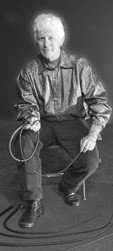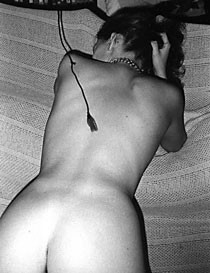 Bullwhip Safety
Bullwhip Safety
A Responsible Top's Primer
Copyright 1997 by Robert Dante, author of
"Bullwhip: Art of the Single Tail Whip"
Author's Forward
Please note that these are recommendations only.
The author cannot accept liability for injuries due
to accidents or irresponsible handling of whips.
BULLWHIP SAFETY FAQ
Let's say that someone you know wants to get a motorcycle. He's never ridden one and the only exposure he's had to bikes are the ones he's seen on TV.
Only a self-destructive idiot would buy one, jump on it and open it up to see what it can do without first learning the basics of safe riding. And yet it's not unusual
to meet someone who's paid top dollar for a Morgan bullwhip without taking the time to learn how to use it, as though the mere possession of such an instrument somehow
magically imparts some superior level of skill to the owner.
Just like motorcycles, bullwhip accidents happen fast and can leave lasting injuries. I have little sympathy for the Top who whacks himself when he's trying something
new, but I have absolutely no respect for the ones who injure others inadvertently because they are simply arrogant in their ignorance.
Even a short four-foot bullwhip can cut like a chainsaw or slice like a knife. A longer one can inflict deep-tissue bruising like a baseball bat. A bullwhip can break
bones.
Expert wielders of single-tail whips have a well-deserved mystique about them. The good ones have paid their dues with patient practice. You can't fake ability with a
bullwhip -- you either have it or you don't. If you've never picked up a bullwhip, I'd like to point you in the right direction. This is one man's opinion, but nothing
here will contradict the practices or the principles of the best whip handlers. If you've been practicing for a while, some of what's said here may validate your own
experiences.
CHOOSING A WHIP
 Pick the right tool for the job. Don't buy an 18-plait, 14-foot kangaroo whip if you want something to play with in an apartment. Don't expect people to happily jump
in front of your 10-foot whip so you can learn how to play with someone. Make your mistakes on your own time -- practice diligently and consistently until you can tell
that whip where to crack every time. When you can take leaves off a tree by fractions of inch at a time, then you're ready to play with someone else.
Pick the right tool for the job. Don't buy an 18-plait, 14-foot kangaroo whip if you want something to play with in an apartment. Don't expect people to happily jump
in front of your 10-foot whip so you can learn how to play with someone. Make your mistakes on your own time -- practice diligently and consistently until you can tell
that whip where to crack every time. When you can take leaves off a tree by fractions of inch at a time, then you're ready to play with someone else.
You do not need an expensive whip; you do need a well-made one. Many beautifully braided whips are mere costume pieces better left hanging on the wall, just because
they do not function the way whips are supposed to. The braiding should be tight enough to communicate the energy of the throw undissipated all the way from the handle
to the cracker. While kangaroo is twice as strong and lighter than leather, it is twice as expensive. Which way you go is your choice. The price of a whip is no indication
of its quality.
Cecil Castro of Texas makes excellent, and inexpensive, whips for the ranchers there -- his whips are simple, almost crude, but they work beautifully once they're
conditioned. At the other end of the spectrum are the whips made by David Morgan (or his employees, under his watchful eye), which are works of art. I've also heard
good things about Rawwhips. One of my own favorites is a leather whip, made with a kangaroo bolster, combining the skins to make a unique instrument.
Like all leather, keep your whip dry. Condition it with tallow, a lanolin-beeswax based mixture. Better yet, obtain some Pecard Conditioner (Pecard Leather Care
Products, 1836 Industrial Drive, Green Bay WI 54302 or call 414-468-5056). Keep neatsfoot oil or any other greasy surface treatment away from it.
Pick the right whip for your purpose. A shorter whip will force you into a stricter form, because it is faster than a longer whip. Because it's shorter, it's also lighter,
so you can practice longer with it before you tire yourself out. Working a long whip is like doing bench presses with one arm. It's easier to go from a shorter whip to a
longer one as your ability increases. A four-foot whip can be used in a variety of situations, while a whip up to 14 feet long will be accurate enough to play contact
games with someone. Beyond that length, don't try anything more elaborate than simple wraps around extended limbs.
PRACTICING
 Get a good video, if you can't find a local whip user to share information. I've produced one, "Bullwhip: Art of the Single Tail Whip." Mark Allen Productions has a series, "Cracking the Whip, I & II." Dressing For Pleasure in New Jersey has tapes of whip seminars from past conferences. If you're on the Internet, there's a good bullwhip FAQ which can be accessed at www.bullwhip.org
Attend conferences. Understand that non-SM people also like to crack the whip, and you can meet them at events such as those sponsored by the Wild West Arts Club (call
702-873-1100 for information). Get a good video, if you can't find a local whip user to share information. I've produced one, "Bullwhip: Art of the Single Tail Whip." Mark Allen Productions has a series, "Cracking the Whip, I & II." Dressing For Pleasure in New Jersey has tapes of whip seminars from past conferences. If you're on the Internet, there's a good bullwhip FAQ which can be accessed at www.bullwhip.org
Attend conferences. Understand that non-SM people also like to crack the whip, and you can meet them at events such as those sponsored by the Wild West Arts Club (call
702-873-1100 for information).
Once you've got your whip, practice, practice, practice. Make sure the floor is clear of objects that might fly off like bullets if you strike them. Outside, rocks or
pebbles can be launched like missiles if your whip hits them. Since a whip is a three-dimensional experience, make sure you have clearance in front, behind and above
you.
Expect to smack yourself. Wear glasses, a hat, long sleeves. If you put your eye out, you won't grow a new one, so protect what you have. Keep the whip moving away
from you; never crack it with a downward snap so the whip flies toward your face. Develop a repertoire of strokes: there are basically three: the overhead shot straight
forward, the circus crack (an S-shape) and the helicopter spin over your head with a sudden reverse. Everything else is a variation on these strokes.
Concentrate on your form. It doesn't take strength or power or speed to crack a whip: if your form is correct, the whip will crack. It wants to crack -- it was made
that way. Let it do its job.
Remember that using a whip is a whole-body activity, not just a wrist-snap. Use a passive wrist, not an active wrist. Use your whole arm. Later, you can add a little
wrist action to give an extra grace-note, but the foundation of the stroke will originate with your whole arm. Get that elbow away from your side, unless you like the
idea of carpal tunnel surgery in your future.
Learn to weave your own crackers; it's less expensive than buying them.
Play games to sharpen your skills: cut newspapers, crack between boxes on chairs without touching the boxes, wrap broomsticks and chair legs.
PLAYING
Never crack directly onto the skin at the point where the sound detonates, unless you want to risk cutting. When a Top wraps an arm, the whip cracks above and behind the
skin: once the whip has cracked, the energy is expended and the momentum of the throw makes the whip wrap like a snake around the arm. Good Tops can make the crack and
wrap occur almost simultaneously. It's scary, but it's non-injurious.
You can play so the cracker hits the skin, if you use this same principle and make the crack occur before you hit flesh. The cracker brushes the skin on its way back --
if you make the crack occur fairly close to the strike, the bottom believes it was simultaneous. Yes, you can use a whip to lay in a stroke for real, understanding that
it will raise a welt or a blood blister. Use a thicker string for the cracker -- a sharper one like silk is more likely to actually cut.
Even with bullwhip play, follow the precepts for other whip play: always warm the bottom up first, and stay away from kidneys and thin tissue areas, like joints. DON'T
PLAY AROUND THE FACE. Understand that a whip has a range of expressions available, not just a single speed and force. Make it a dance.
A shorter whip will be more precise for edge play like this. Keep the area clean; even if skin is not broken, you are still driving dirt into the skin. Keep the whip
off the floor (I use alcohol on my crackers). Clean your whips between sessions.
The same safety rules for yourself apply to your bottom. Keep the whip moving away from his/her face. NO NECK WRAPS (leave this for the movies). Stay away from the
eyes. Play as though this is the time you will screw up royally -- that way you'll play with the thought in the back of your mind that you will try to minimize the
damage that will happen. Because if you can fuck up, you WILL fuck up. People forget that Babe Ruth was the Strike-Out King as well as the Home Run King.
There it is. This is not the final word, or perhaps the best one, on the topic of single-tail whips. But what is here is true. At least you've now been told.
For the more academic, there are other books out there well worth reading, including David Morgan's. There are other resources you can find wherever you are (especially
if you're on the Internet).
One of the nice things about the whip is that it is such an individual experience. Every person I've seen who knows how to handle a whip responsibly has his/her own
unique style, but under those idiosyncracies, I see they are based on solid principles, and those principles reflect the same foundations, the way aerodynamic principles
are observed by everything that flies. Once you get your foundation set, you can make your whip express your own personality.
Every violin has the same basic shape and the same number of strings. But in the hands of different people, the music they make reflects the quality of the
player. Here's wishing you many happy hours making music with the instrument many have called "the epitome of S&M."
Copyright 1997 by Robert Dante, author of "Bullwhip: Art of the Single Tail Whip" (video)
|



